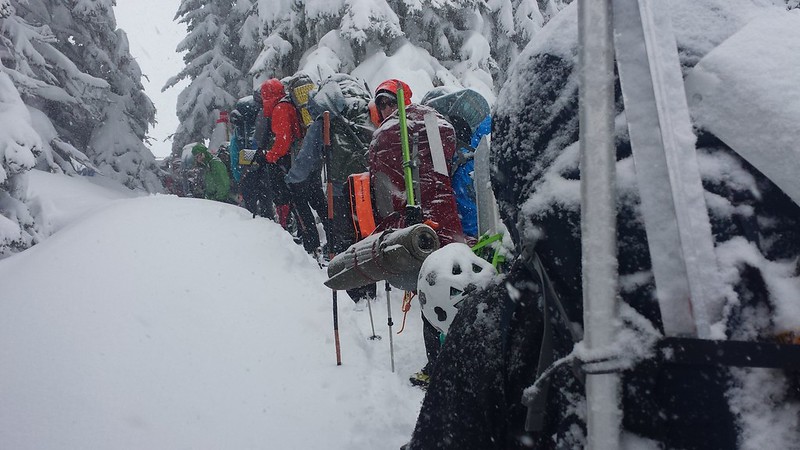
Shortly after noon our party of around 60 were breaking trail through deep, fresh powder. My thanks to all those students wise enough to bring snowshoes, you saved us a lot of post-holing! Snowflakes continued to fall with increasing size throughout the day. After quickly setting up camp we broke into teams and headed up to some modest slopes for practice and testing of our ice ax arrest techniques. Easily my favorite part of the trip, we built glissade chutes and practiced arrests from various fall positions. After testing we ran through the standing ice ax-carabiner belay and proper anchoring technique with a snow picket. Back at camp we prepped for simulated glacier travel in the morning before being excused to our tents.

That night I had my first experience cooking with white gas. Colin's whisper-lite stove seemed a little finicky, but after losing fire once and experimenting with the pressure pump, I am sold on the added efficiency in cold temps and at high elevation. While I boiled water for dinner and hydration several inches of fresh snow accumulated on the base of our rain fly. This forced some maintenance to the tent site as we were expecting close to another foot over night. In addition to glacier travel, I learned a lot on this trip about proper snow camping techniques. There is a fine balance between the size of a vestibule trench, effective anchorage, space to move around the outside, and sufficient room for shedding snow to accumulate without burying the tent. The most important lesson here: be adaptable and resilient.

In the morning my group was geared up and harnessed in before 4 a.m., ready to begin "up the glacier" in two rope teams of 3. We practiced belaying each other out of camp and up the glissade chutes using prusiks, then simulated falls for each other to test ice ax arrests of the rope team. Throughout the simulation I found rope management (not stepping on it with crampons, and pacing with the group) to be the most complicated part, requiring constant attention to detail. On the way down we went through passing a running picket belay and then un-roped to test our ability to construct various bombproof anchors in the snow including the "dead man" and bollard. It was around this time when we were treated with a short break in the clouds. Big Tahoma emerged from the white and sunshine warmed our skin for the first time in days. Our instructor Scott was kind enough to pause the course work for a few minutes while we all enjoyed the brief weather change.

Finally we built emergency snow shelters. I was a bit disappointed that we lacked the time and proper snow conditions to dig a snow cave, but our little trench with an emergency blanket for a roof sufficed for the grade. While we broke down camp Pinnacle Peak and a few other Tatoosh Peaks broke through clouds to the south. By the time we had broken camp and started back, it has stopped snowing and the sun was out to stay. Before leaving we gathered for a much more realistic demonstration of the Z-pulley technique for crevasse rescue (the first demonstration was at the Seattle facility on carpet), which I look forward to practicing myself with Colin and a few others after our next adventure in the snow.

This weekend was a blast! Many thanks to all of the instructors for volunteering their time and subjecting themselves to crappy weather. You make it all possible!